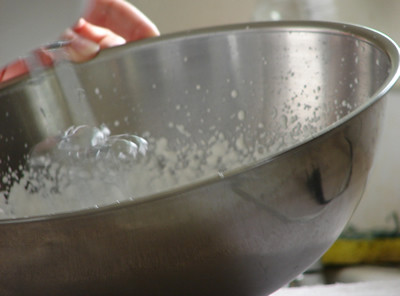Perfectly whipped cream can lift up a dish immensely: soft, creamy and light with a hint of sweetness, it’s a perfect accompaniment to cakes and tarts, or as an ingredient in mousses and other desserts. sweetness, it’s a perfect accompaniment to cakes and tarts, or as an ingredient in mousses and other desserts. When making perfect whipped cream, there are a few things to keep in mind. The Cream
You will get the best result if you utilize heavy cream as opposed to whipping cream. Fat carries flavor, and heavy cream has a higher fat content than whipping cream. Further, cream has the most flavor when it hasn’t been pasteurized since that process destroys proteins that contain flavor. Therefore don’t use ultra pasteurized heavy cream, use regular pasteurized heavy cream (ultra pasteurized cream has been heated for a longer period of time than pasteurized cream which gives the ultra pasteurized cream longer shelf life but less flavor). Temperature
It’s important to utilize chilled cream, as it will beat more easily and form nicer peaks. To keep the cream cold as you whisk it, chill the mixing bowl and beaters by keeping it in the fridge before you start whisking. A stainless steel bowl is a good choice since it keeps the cream colder.
Sweetness
If you like your cream slightly sweet, then you should add regular granulated sugar to the cream before you start whipping. If you use too much powdered sugar, the flavor can be effected by the corn starch that’s in powdered sugar, therefore use regular sugar. However you do need to add the sugar to the cream before you start whisking in order for the sugar crystals to incorporate into the cream. Some vanilla extract also adds a nice touch to the cream.
For slightly sweetened cream, we use these measurements: - 1 ½ cups of cream
- 1 ½ tablespoon granulated sugar
- ½ teaspoon vanilla extract.
Whipping
You can whip your cream by hand, with a hand mixer or with a stand mixer. If you are whipping your cream by hand, then utilize a large whisk and continuously beat the cream from an angle in order to let as much air as possible into the cream. If you are using a mixer (it's certainly easier, especially if you’re making a lot of whipped cream) then start off on low and increase the speed as you go.
When the cream has almost reached your desired consistency, it’s a good idea to finish off whipping it by hand. Whipped cream can go from under-whipped to over-whipped very quickly, and if you would over-whip your cream you can’t go back. At that stage, the cream starts to curdle and turn into butter and you need to start off with a fresh batch of cream. Most recipes call for soft or stiff peaks which you can tell by lifting your whisk up and look at the shape of the peaks. If they are soft and slightly bent over, you have soft peaks and if they are hard and firm you have stiff peaks.
Whipped cream can be stored in the refrigerator for a day or two, however it’s best when freshly whipped.
| 
